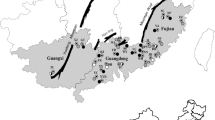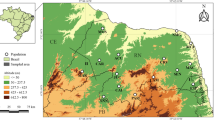Abstract
The genetic composition of Melampsora larici-epitea populations on two Salix viminalis varieties in monoculture and in mixed stands of Salix was studied using amplified fragment length polymorphism (AFLP). A total of 88 isolates collected from a large-scale mixture trial in Northern Ireland were analyzed. Genetic analyses were based on polymorphism for 63 AFLP markers. Differences in genetic composition of M. larici-epitea populations between the two S. viminalis varieties were indicated by all population characteristics used. In neighbor-joining analysis and principal component analysis, isolates from the same variety tended to group together. Analysis of molecular variance indicated a substantial differentiation between varieties (ΦST = 0.20) and differences in genotypic composition was indicated by the non-random distribution of clonal isolates between the two varieties. The detection of host specialization with selectively neutral DNA markers was ascribed to predominant asexual reproduction. No differences in gene or genotypic diversity between M. larici-epitea populations in mixed and monoclonal stands were found for any of the two S. viminalis varieties.
Similar content being viewed by others
References
Armstrong J, Gibbs A, Peakall R and Weiller G (1996) The Rapdistance Package, Version 1.04. Australian National University, Canberra
Burdon JJ and Roberts JK (1995) The population genetic structure of the rust fungus Melampsora lini as revealed by pathogenicity, isozyme and RFLP markers. Plant Pathology 44: 270-278
Burdon JJ and Roelfs AP (1985) The effect of sexual and asexual reproduction on the isozyme structure of populations of Puccinia graminis. Phytopathology 75: 1068-1073
Chen X, Line RF and Leung H (1993) Relationship between virulence variation and DNA polymorphism in Puccinia striiformis. Phytopathology 83: 1489-1497
Excoffier L, Smouse PE and Quattro JM (1992) Analysis of molecular variance inferred from metric distances among DNA haplotypes: Application to human mitocondrial DNA restriction sites. Genetics 131: 479-491
Felsenstein J (1993) PHYLIP (Phylogeny Inference Package) version 3.5c. Distributed by the author. Department of Genetics, University of Washington, Seattle
Finckh MR, Gacek ES, Goyeau H, Lannou C, Merz U, Mundt CC, Munk L, Nadziak J, Newton AC, de Vallavieille-Pope C and Wolfe MS (2000) Cereal variety and species mixtures in practice, with emphasis on disease resistance. Agronomie 20: 813-837
Goodwin SB, Spielman L, Matuszak JM, Bergeron SN and Fry WE (1992) Clonal diversity and genetic differentiation of Phytophtora infestans populations in northern and central Mexico. Phytopathology 82: 955-961
Gullberg U and Ryttman H (1993) Genetics of field resistance to Melampsora rust in Salix viminalis. European Journal of Forest Pathology 23: 75-84
Hunter T, Royle DJ and Arnold GM (1996) Variation in the occurrence of rust (Melampsora spp.) and other diseases and pests, in short-rotation coppice plantations of Salix in the British Isles. Annals of applied Biology 129: 1-12
Lascoux M, Ramstedt M, Åström B and Gullberg U (1996) Components of resistance of leaf rust (Melampsora laricii-epitea Kleb./Melampsora ribesii-viminalis Kleb.) in Salix viminalis L. Theoretical and Applied Genetics 93: 1310-1318
Liu JQ and Kolmer JA (1998) Molecular and virulence diversity and linkage disequilibria in asexual and sexual populations of the wheat leaf rust fungus, Puccinia recondita. Genome 41: 832-840
McCracken AR and Dawson M (1992) Clonal response in Salix to Melampsora rusts in short rotation coppice plantations. European Journal of Forest Pathology 22: 19-28
McCracken AR and Dawson WM (1998) Short rotation coppice willow in Northern Ireland since 1973: Development of the use of mixtures in the control of foliar rust (Melampsora spp.). European Journal of Forest Pathology 28: 241-250
McCracken AR, Dawson WM, Watson S and Allen CY (2000) Pathotype composition in Melampsora epitea populations occuring on willow (Salix) grown in mixed and monoculture plantations. European Journal of Plant Pathology 106: 879-886
McDonald BA, Pettway RE, Chen RS, Boeger JM and Martinez JP (1995) The population genetics of Septoria tritici (teleomorph Mycosphaerella graminicola). Canadian Journal of Botany 73 (suppl 1): S292-S301
Milgroom MG (1996) Recombination and the multilocus structure of fungal pathogens. Annual Review of Phytopathology 34: 457-477
Nei M and Li WH (1979) Mathematical model for studying genetic variation in terms of restriction endonucleases. Proceedings of the National Academy of Sciences of the USA 76: 5269-5273
Newton AC and Thomas WTB (1992) The effect of specific and non-specific resistance in mixtures of barley or genotypes on infection by mildew (Erysiphe graminis f.sp. hordei) and on yield. Euphytica 59: 73-81
Page RDM (1996) TREEVIEW: An application to display phylogenetic trees on personal computers. Computer Applications in the Biosciences 12: 357-358
Pei MH, Royle DJ and Hunter T (1996) Pathogenic specialization in Melampsora epitea var. epitea on Salix. Plant Pathology 45: 679-690
Pei MH, Parker SR, Hunter T and Royle DJ (1997) Variation in populations of Melampsora willowrust and the implications for design of short rotation coppice plantation. Aspects of Applied Biology 49: 91-96
Pei MH, Royle DJ and Hunter T (1999) Hybridization in larchalternating Melampsora epitea (M. larici-epitea). Mycological Research 103(11): 1440-1446
Pei MH, Yuan ZW, Hunter T and Ruiz C (2000) Heterogeneous nature of a 'new' pathotype of Melampsora rust on Salix revealed by AFLP. European Journal of Plant Pathology 106: 771-779
Ramstedt M (1999) Rust disease on willows-virulence variation and resistance breeding strategies. Forest Ecology and Management 121: 101-111
Rönnberg-Wästljung AC and Gullberg U (1999) Genetics of breeding characters with possible effects on biomass production in Salix viminalis (L.). Theoretical and Applied Genetics 98: 531-540
Samils B, Lagercrantz U, Lascoux M and Gullberg U (2001a) Genetic structure of Melampsora epitea populations in Swedish Salix viminalis plantations. European Journal of Plant Pathology 107: 399-409
Samils B, Stepien V, Lagercrantz U, Lascoux M and Gullberg U (2001b) Genetic diversity in relation to sexual and asexual reproduction in populations of Melampsora larici-epitea. European Journal of Plant Pathology 107: 871-881
Saitou N and Nei M (1987) The neighbor-joining method: Anewmethod for reconstructing phylogenetic trees. Molecular Biology and Evolution 4: 406-425
Schneider S, Kueffer JM, Roessli D and Excoffier L (1997) Arlequin ver 1.1: A software for population genetic data analysis. Genetic and Biometry Laboratory, University of Geneva, Switzerland
Sheldon AL (1969) Equitability indices: Dependance on the species count. Ecology 50: 466-467
Van de Peer Y and De Wachter R (1994) TREECONforWindows: A software package for the construction and drawing of evolutionary trees for the Microsoft Windows environment. Computer Applications in the Biosciences 10: 569-570
Verwijst T (1990) Clonal differences in the structure of a mixed stand of Salix viminalis in response to Melampsora and frost. Canadian Journal of Forest Research 20: 602-605
Vos P, Hogers MB, Reijans M, van de Lee T, Hornes M, Frijters A, Pot J, Peleman J, Kuiper M and Zabeau M (1995) AFLP:Anew technique for DNA fingerprinting. Nucleic Acids Research 23: 4407-4414
Wolfe MS (1985) The current status and prospects of multiline cultivars and variety mixtures for disease resistance. Annual Review of Phytopathology 23: 251-273
Wolfe MS (1992) Maintaining the value of our varieties. In: Munk L (ed) Barley Genetics VI, Vol 2 (pp 1055-1067). Munksgaard International Publishers, Copenhagen
Xu XM and Ridout MS (2000) Stochastic simulation of the spread of race-specific and race-nonspecific aerial fungal pathogens in cultivar mixtures. Plant Pathology 49: 207-218
Zhu Y, Chen H, Fan J, Wang Y, Li Y, Chen J, Fan J, Yang S, Hu L, Leung H, Mew TW, Teng PS, Wang Z and Mundt CC (2000) Genetic diversity and disease control in rice. Nature 406: 718-722
Author information
Authors and Affiliations
Rights and permissions
About this article
Cite this article
Samils, B., McCracken, A., Dawson, W. et al. Host-specific Genetic Composition of Melampsora larici-epitea Populations on Two Salix viminalis Varieties in a Mixture Trial. European Journal of Plant Pathology 109, 183–190 (2003). https://doi.org/10.1023/A:1022545318466
Issue Date:
DOI: https://doi.org/10.1023/A:1022545318466




